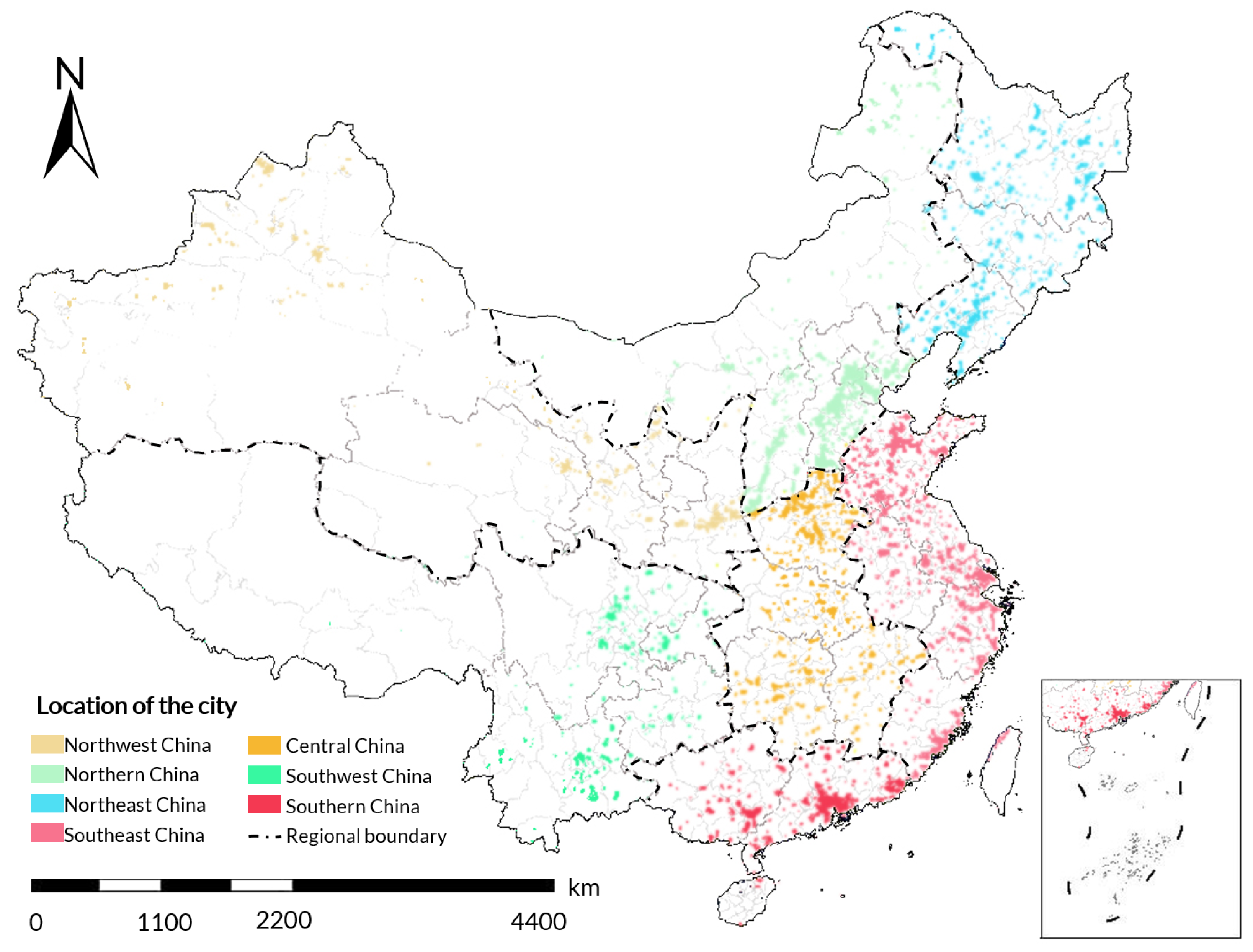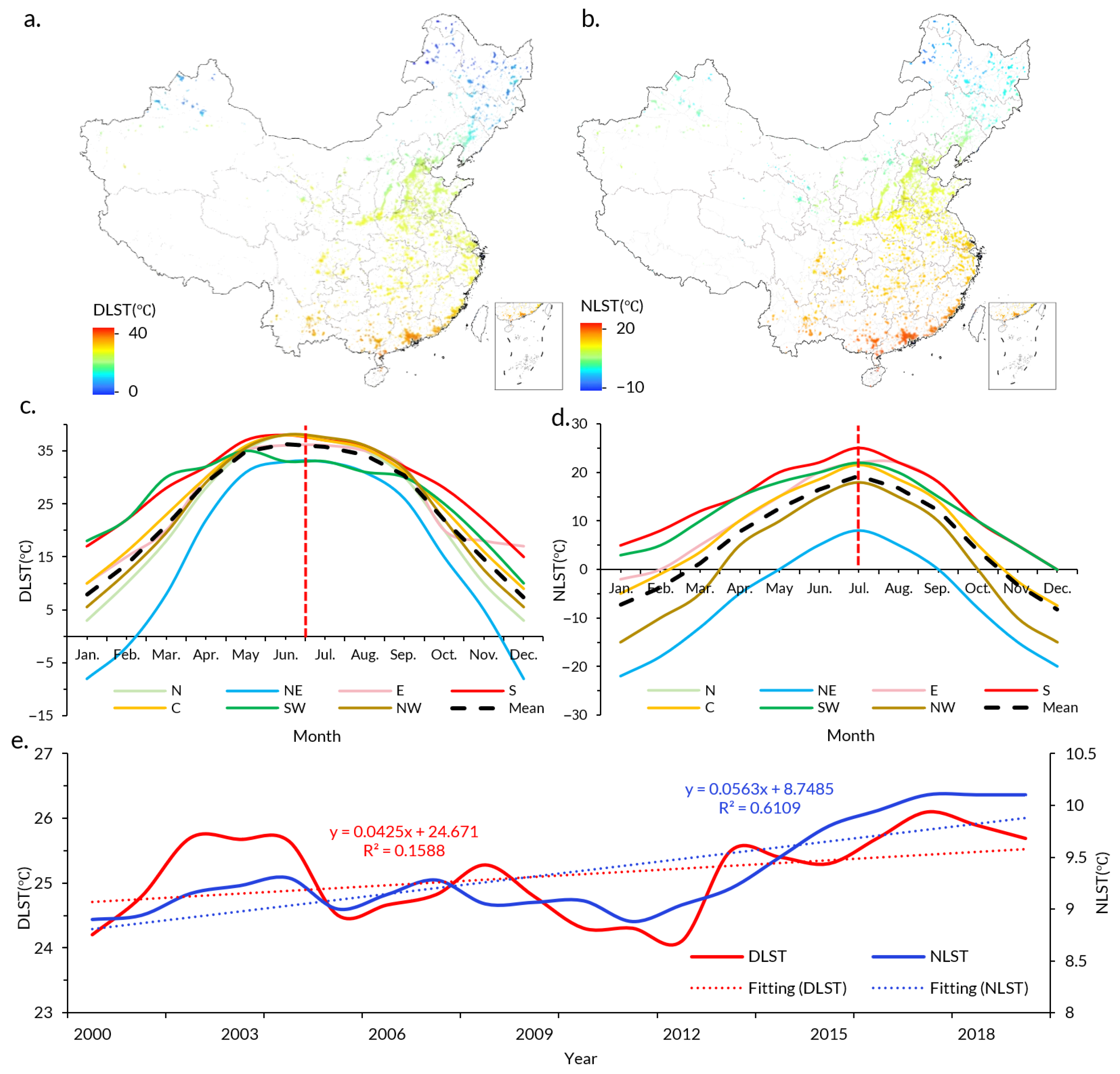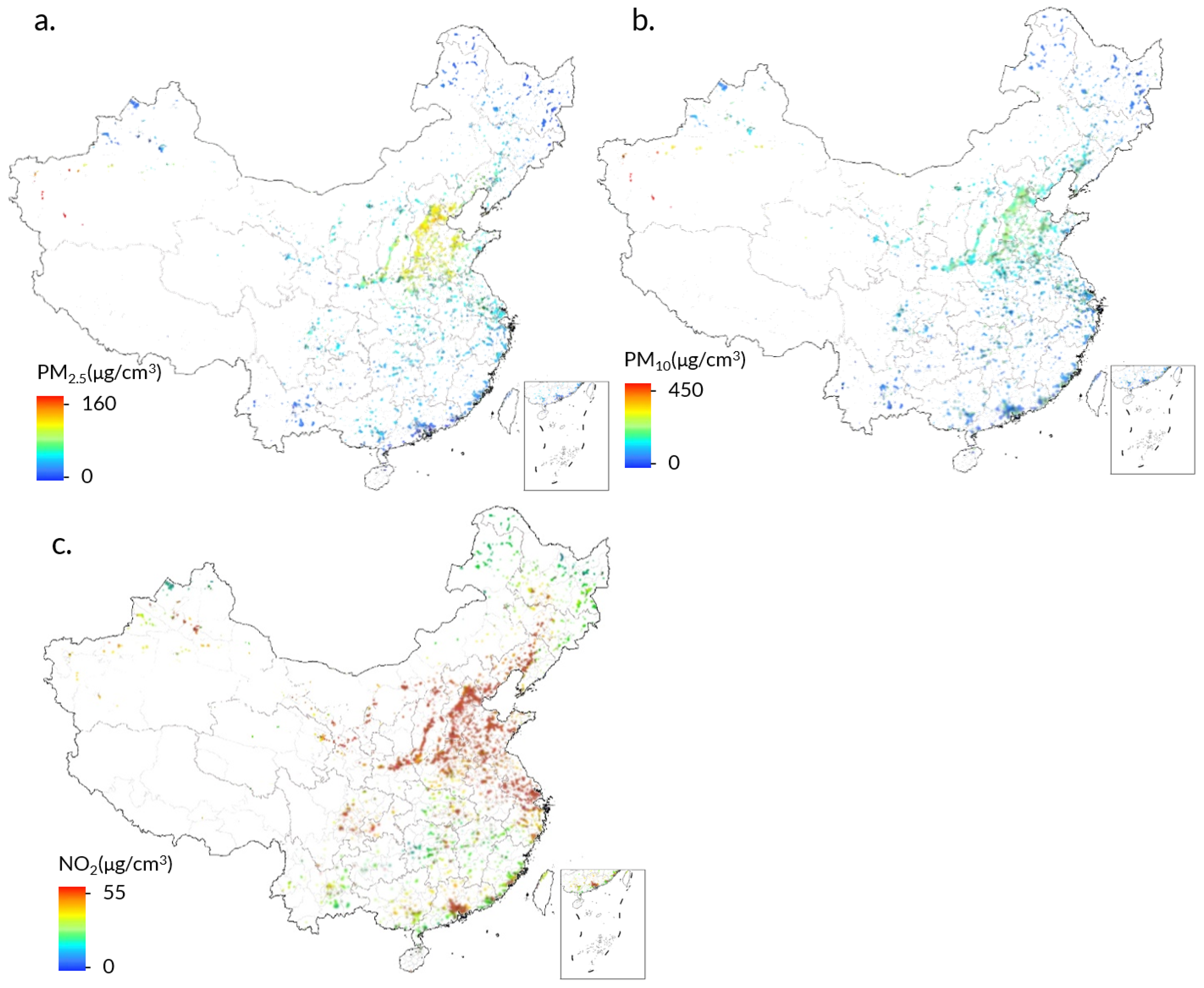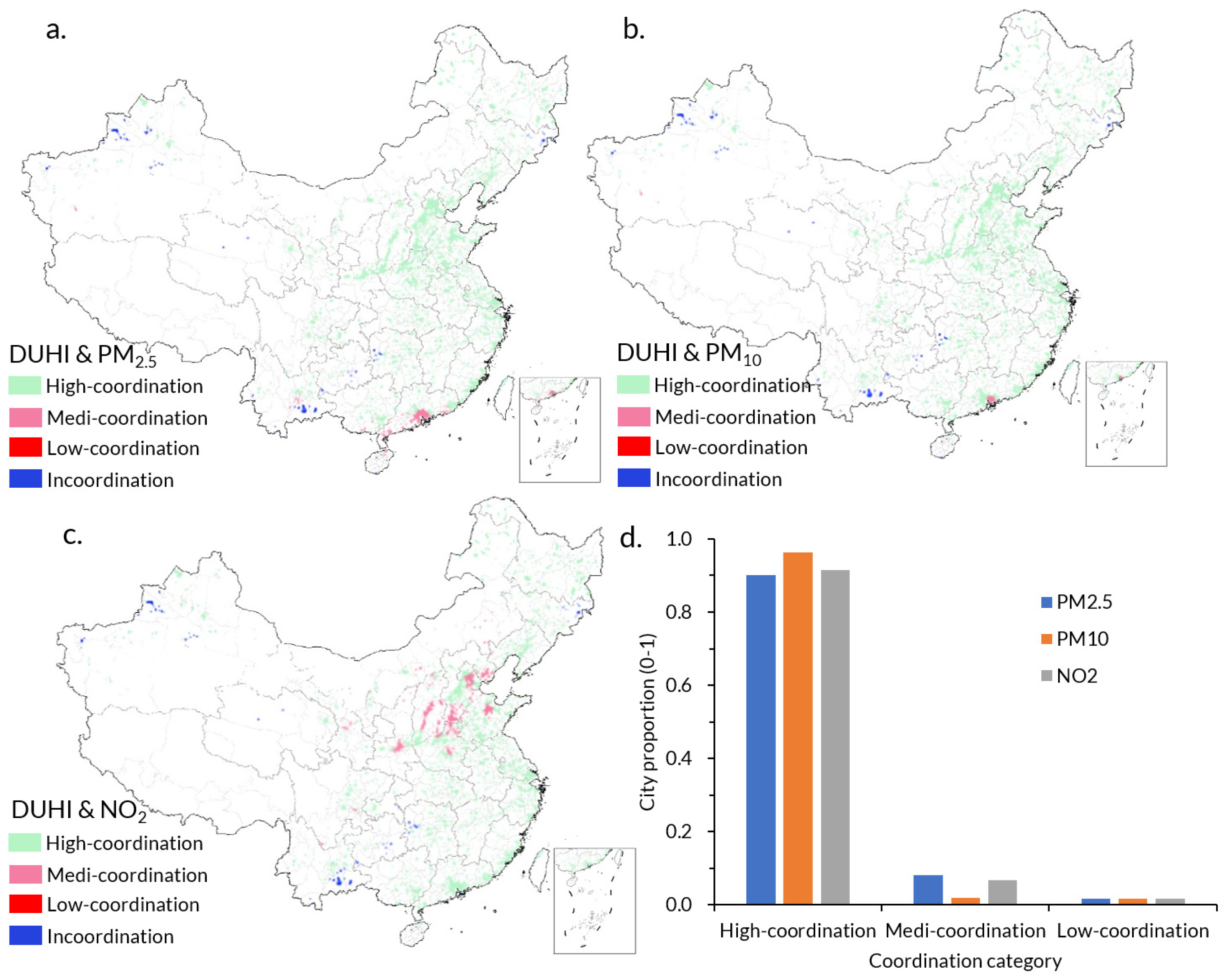Synergistic Mechanism of Spatiotemporal Dynamics in Urban Thermal Environments and Air Pollutants in China
Highlights
- Nighttime land surface temperature increased faster than daytime temperature.
- Over 90% of cities show high coordination between urban heat and air pollution.
- Strengthening correlation between thermal environment and air pollution is observed.
- Strengthening positive feedback between air pollution and nighttime heat islands.
Abstract
1. Introduction
2. Materials and Methods
2.1. Study Area
2.2. Data Source
2.3. Calculation of Thermal Environment Indicators
2.4. Calculation of Urban Characteristic Indicators
2.5. Spatial Coupling Analysis
2.6. Correlation Analysis
3. Results
3.1. Spatiotemporal Dynamics of Urban LST in China
3.2. Spatiotemporal Dynamics of UHI Data in China
3.3. Spatiotemporal Dynamics of Urban Air Pollution in China
3.4. Temporal Consistency Between the Thermal Environment and Air Pollutant Changes
3.5. Spatial Coupling Degree Between Thermal Environment and Air Pollutant
3.6. Synergistic Driving Factors of Thermal Pollution Environment Dynamics
4. Discussion
4.1. Theoretical Application
4.2. Implications for Environmental Management
4.3. Policy Governance Suggestions
4.3.1. Controlling Anthropogenic Heat–Pollution–Carbon Synergy
4.3.2. Regulating the Urban Form and Land Use
4.3.3. Systematically Enhancing the Natural Mitigation Capacity
4.3.4. Towards a Multi-Dimensional Governance Framework
4.4. Limitations and Uncertainties
5. Conclusions
Author Contributions
Funding
Data Availability Statement
Acknowledgments
Conflicts of Interest
Abbreviations
| LST | Land surface temperature |
| NLST | Nighttime LST |
| DLST | Daytime LST |
| UHI | Urban heat island |
| NUHI | Nighttime UHI intensity |
| DUHI | Daytime UHI intensity |
| UA | Urban area |
| US | Urban shape |
| BD | 3D building density |
| DEM | Digital elevation model |
| T | Temperature |
| P | Precipitation |
| WS | Wind speed |
| TSR | Total solar radiation |
| PD | Population density |
| NAI | Nighttime activity intensity |
| CE | Carbon emission |
| TP | Tree cover proportion |
| RP | Residential proportion |
| IP | Industrial proportion |
References
- Abbassi, Y.; Ahmadikia, H.; Baniasadi, E. Impact of wind speed on urban heat and pollution islands. Urban Clim. 2022, 44, 101200. [Google Scholar] [CrossRef]
- Arunab, K.S.; Mathew, A. Quantifying urban heat island and pollutant nexus: A novel geospatial approach. Sustain. Cities Soc. 2024, 101, 105117. [Google Scholar] [CrossRef]
- Bagienski, Z. Traffic air quality index. Sci. Total Environ. 2015, 505, 606–614. [Google Scholar] [CrossRef] [PubMed]
- Biagi, B.; Brattich, E.; Cintolesi, C.; Barbano, F.; Di Sabatino, S. Dynamical and chemical impacts of urban green areas on air pollution in a city environment. Urban Clim. 2025, 60, 102343. [Google Scholar] [CrossRef]
- Ciacci, C.; Banti, N.; Di Naso, V.; Bazzocchi, F. Green strategies for improving urban microclimate and air quality: A case study of an Italian industrial district and facility. Build. Environ. 2023, 244, 110762. [Google Scholar] [CrossRef]
- Fan, Y.F.; Hunt, J.L.; Wang, Q.; Yin, S.; Li, Y.G. Water tank modelling of variations in inversion breakup over a circular city. Build. Environ. 2019, 164, 106342. [Google Scholar] [CrossRef]
- Chen, W.; Zhang, J.J.; Huang, C.Y.; Fu, S.; Liang, S.; Wang, K. Measuring heat transfer index (HTI): A new method to quantify the spatial influence of land surface temperature between adjacent urban spaces. Sustain. Cities Soc. 2025, 122, 106268. [Google Scholar] [CrossRef]
- Han, L.; Zhang, R.J.; Wang, J.Q.; Cao, S.J. Spatial synergistic effect of urban green space ecosystem on air pollution and heat island effect. Urban Clim. 2024, 55, 101940. [Google Scholar] [CrossRef]
- Gobakis, K.; Kolokotsa, D.; Synnefa, A.; Saliari, M.; Giannopoulou, K.; Santamouris, M. Development of a model for urban heat island prediction using neural network techniques. Sustain. Cities Soc. 2011, 1, 104–115. [Google Scholar] [CrossRef]
- Liu, S.; Zhang, J.; Li, J.; Li, Y.; Zhang, J.; Wu, X. Simulating and mitigating extreme urban heat island effects in a factory area based on machine learning. Build. Environ. 2021, 202, 108051. [Google Scholar] [CrossRef]
- Jiang, Y.; Lin, W.P.; Xu, D.; Xu, D. Spatio-temporal variation of the relationship between air pollutants and land surface temperature in the Yangtze River Delta Urban Agglomeration, China. Sustain. Cities Soc. 2023, 91, 104429. [Google Scholar] [CrossRef]
- Lai, L.W.; Cheng, W.L. Air quality influenced by urban heat island coupled with synoptic weather patterns. Sci. Total Environ. 2009, 407, 2724–2733. [Google Scholar] [CrossRef]
- Lopes, H.S.; Vidal, D.G.; Cherif, N.; Silva, L.; Remoaldo, P.C. Green infrastructure and its influence on urban heat island, heat risk, and air pollution: A case study of Porto (Portugal). J. Environ. Manag. 2025, 376, 124446. [Google Scholar] [CrossRef] [PubMed]
- Luan, Q.Z.; Yang, M.C.; Feng, T.Q.; Huang, W.L. Analysis of the urban turbidity island effect: A case study in Beijing City, China. Environ. Res. Lett. 2023, 18, 024010. [Google Scholar] [CrossRef]
- Milesi, C.; Churkina, G. Measuring and Monitoring Urban Impacts on Climate Change from Space. Remote Sens. 2020, 12, 3494. [Google Scholar] [CrossRef]
- Park, K.; Baik, J.J. Nonlinear changes in urban heat island intensity, urban breeze intensity, and urban air pollutant concentration with roof albedo. Sci. Rep. 2024, 14, 24911. [Google Scholar] [CrossRef]
- Parida, B.R.; Bar, S.; Kaskaoutis, D.; Pandey, A.C.; Polade, S.D.; Goswami, S. Impact of COVID-19 induced lockdown on land surface temperature, aerosol, and urban heat in Europe and North America. Sustain. Cities Soc. 2021, 75, 103336. [Google Scholar] [CrossRef]
- Shen, P.Y.; Wang, M.L.; Ma, H.; Ma, N. On the two-way interactions of urban thermal environment and air pollution: A review of synergies for identifying climate-resilient mitigation strategies. Build. Simul. 2025, 18, 259–279. [Google Scholar] [CrossRef]
- Chen, W.; Zhang, J.J.; Zhang, Y.P.; Fu, S.; Yi, K.X.; Dai, Y.X. Heating pattern and effects of built-up land in response to influencing factors: A statistical estimation of 172 Chinese cities. J. Clean. Prod. 2024, 474, 143589. [Google Scholar] [CrossRef]
- Suthar, G.; Kaul, N.; Khandelwal, S.; Singh, S. Predicting land surface temperature and examining its relationship with air pollution and urban parameters in Bengaluru: A machine learning approach. Urban Clim. 2024, 53, 101830. [Google Scholar] [CrossRef]
- Simpson, C.H.; Brousse, O.; Heaviside, C. Estimated mortality attributable to the urban heat island during the record-breaking 2022 heatwave in London. Environ. Res. Lett. 2024, 19, 094047. [Google Scholar] [CrossRef]
- Suthar, G.; Singh, S.; Kaul, N.; Khandelwal, S. Understanding the multifaceted influence of urbanization, spectral indices, and air pollutants on land surface temperature variability in Hyderabad, India. J. Clean. Prod. 2024, 470, 143284. [Google Scholar] [CrossRef]
- Taha, H. Cool Cities: Counteracting Potential Climate Change and its Health Impacts. Curr. Clim. Change Rep. 2015, 1, 163–175. [Google Scholar] [CrossRef]
- Tang, Y.F.; Chen, H.; Yang, M.; Tan, Z.C.; Zhao, F.Y.; Guo, J.H.; Fang, Y.P. Weak geostrophic wind driven ventilation in street canyons with trees and green walls: Cooperating or opposing dispersions of airborne pollutants? Build. Environ. 2024, 259, 111654. [Google Scholar] [CrossRef]
- Wang, Y.; Li, Y.; Di Sabatino, S.; Martilli, A.; Chan, P.W. Effects of anthropogenic heat due to air-conditioning systems on an extreme high temperature event in Hong Kong. Environ. Res. Lett. 2018, 13, 034015. [Google Scholar] [CrossRef]
- Wang, Y.Y.; Guo, Z.Y.; Han, J. The relationship between urban heat island and air pollutants and them with influencing factors in the Yangtze River Delta, China. Ecol. Indic. 2021, 129, 107976. [Google Scholar] [CrossRef]
- Ngarambe, J.; Joen, S.J.; Han, C.H.; Yun, G.Y. Exploring the relationship between particulate matter, CO, SO2, NO2, O3 and urban heat island in Seoul, Korea. J. Hazard. Mater. 2021, 403, 123615. [Google Scholar] [CrossRef]
- Weng, Q.H.; Firozjaei, M.K.; Sedighi, A.; Kiavarz, M.; Alavipanah, S.K. Statistical analysis of surface urban heat island intensity variations: A case study of Babol city, Iran. GIScience Remote Sens. 2019, 56, 576–604. [Google Scholar] [CrossRef]
- Wu, S.H.; Wang, Y.; Chen, C.W.; Cao, Z.X.; Cao, J.X.; Yu, Z.L.; Song, H. Valley city ventilation under the calm and stable weather conditions: A review. Build. Environ. 2021, 194, 107668. [Google Scholar] [CrossRef]
- Wu, Q.Y.; Huang, Y.H.; Irga, P.; Kumar, P.; Li, W.G.; Wei, W.; Shon, H.K.; Lei, C.W.; Zhou, J.L. Synergistic control of urban heat island and urban pollution island effects using green infrastructure. J. Environ. Manag. 2024, 370, 122985. [Google Scholar] [CrossRef]
- Zhang, P.Y.; Zhang, J.B.; Liu, Z.Y.; Liu, Y.; Chen, Z. Relationship between land surface temperature and air quality in urban and suburban areas: Dynamic changes and interaction effects. Sustain. Cities Soc. 2025, 118, 106043. [Google Scholar] [CrossRef]
- Yin, M.Q.; He, B.J. Performance-based urban ventilation corridor for actual achievement of environmental benefits. Build. Environ. 2025, 270, 112536. [Google Scholar] [CrossRef]
- Zhong, S.; Qian, Y.; Sarangi, C.; Zhao, C.; Leung, R.; Wang, H.L.; Yan, H.P.; Yang, T.; Yang, B. Urbanization Effect on Winter Haze in the Yangtze River Delta Region of China. Geophys. Res. Lett. 2018, 45, 6710–6718. [Google Scholar] [CrossRef]
- Wan, Z. New refinements and validation of the collection-6 MODIS land-surface temperature/emissivity product. Remote Sens. Environ. 2014, 140, 36–45. [Google Scholar] [CrossRef]
- Fang, Y.H.; Gu, K.K. Exploring coupling effect between urban heat island effect and PM2.5 concentrations from the perspective of spatial environment. Environ. Eng. Res. 2022, 27, 200559. [Google Scholar] [CrossRef]
- Wu, Q.; Hong, S.; Yang, L.; Mu, H.; Huang, C.; Niu, X.; Zhong, Y.; Yi, J.; He, C. Coupling coordination relationships between air pollutant concentrations and emissions in China. Atmos. Pollut. Res. 2023, 14, 101678. [Google Scholar] [CrossRef]
- Sun, Q.; Zhao, X.; Hua, Y. Dynamic Coupling Between Atmospheric CO2 Concentration and Land Surface Temperature in Major Urban Agglomerations in China: Insights for Sustainable Urban Development. Sustainability 2024, 16, 9484. [Google Scholar] [CrossRef]
- GB 3095-2012; China’s Ambient Air Quality Standards. Ministry of Ecology and Environment of the People’s Republic of China: Beijing, China, 2012.
- Zhang, X.; Brandt, M.; Tong, X.; Tong, X.; Zhang, W.; Reiner, F.; Li, S.; Tian, F.; Yue, Y.; Zhou, W.; et al. A strong but uneven increase in urban tree cover in China over the recent decade. Nature Cities 2025, 2, 460–469. [Google Scholar] [CrossRef]
- Liu, S.D.; Zhang, J.; Wang, L.; Ciais, P.; Zhang, J.J.; Penuelas, J.; Nath, B.; Jacquet, I.; Wu, X.; Ding, S.P.; et al. Mapping previously undetected trees reveals overlooked changes in pan-tropical tree cover. Nat. Commun. 2025, 16, 5561. [Google Scholar] [CrossRef]
- Liu, S.; Zhang, J.; Wu, X.; Chen, W.; Jie, Z. Potential thermal constraints for sustainable industrial city: Refined simulation and prediction of extreme urban heat island effect. Sustain. Cities Soc. 2024, 105, 105342. [Google Scholar] [CrossRef]
- Liu, S.; Zhang, J.; Wang, K.; Wu, X.; Chen, W.; Liang, S.; Zhang, Y.; Fu, S. Structural indicator synergy for mitigating extreme urban heat island effects in industrial city: Simulation and verification based on machine learning. Ecol. Indicators 2023, 157, 111216. [Google Scholar] [CrossRef]
- Liu, S.; Zhang, J.; Zhang, J. New sights on the impact of spatial composition of production factors for socioeconomic recovery in the post-epidemic era: A case study of cities in central and eastern China. Sustain. Cities Soc. 2022, 85, 104061. [Google Scholar] [CrossRef]
- Ma, Y.J.; Xin, J.Y.; Wang, Z.F.; Tian, Y.L.; Wu, L.; Tang, G.Q.; Zhang, W.Y.; de Arellano, J.V.G.; Zhao, D.D.; Jia, D.J.; et al. How do aerosols above the residual layer affect the planetary boundary layer height? Sci. Tot. Environ. 2022, 814, 151953. [Google Scholar] [CrossRef]
- Sethi, S.S.; Vinoj, V. Transported dust modulates aerosol pollution domes over rapidly urbanizing Indian cities. Commun. Earth Environ. 2025, 6, 554. [Google Scholar] [CrossRef]
- Alpert, P.; Kishcha, P.; Kaufman, Y.J.; Schwarzbard, R. Global dimming or local dimming?: Effect of urbanization on sunlight availability. Geophys. Res. Lett. 2005, 32. [Google Scholar] [CrossRef]
- He, Y.Y.; Wang, K.C.; Zhou, C.; Wild, M. A Revisit of Global Dimming and Brightening Based on the Sunshine Duration. Geophys. Res. Lett. 2018, 45, 4281–4289. [Google Scholar] [CrossRef]
- Liu, S.; Geng, Y.; Zhang, J.; Kang, X.; Shi, X.; Zhang, J. Ecological trap in tourism-urbanization: Simulating the stagnation and restoration of urbanization from the perspective of government incentives. Ecol. Econ. 2021, 185, 107054. [Google Scholar] [CrossRef]
- Liu, S.; Zhang, J.; Geng, Y.; Li, J.; Wang, Y.; Zhang, J. Plausible response of urban encroachment on ecological land to tourism growth and implications for sustainable management, a case study of Zhangjiajie, China. Ecol. Indicators 2021, 132, 108253. [Google Scholar] [CrossRef]









| Data Type | Indicators | Period | Resolution | Data Source |
|---|---|---|---|---|
| Thermal environment | LST, UHI | 2000–2019 | 1 km | MODIS surface temperature product: https://lpdaac.usgs.gov/products/myd11a2v061/ accessed on 21 May 2025 |
| Air pollution | PM2.5, PM10, NO2 | 2000–2019 | Shp | Air quality project released by the Chinese Ministry of Environmental Protection: https://www.cnemc.cn/ accessed on 23 February 2025 |
| Urban boundary | Urban area (UA), Urban shape (US) | 2018 | Shp | Global Urban Boundaries: http://data.ess.tsinghua.edu.cn/ accessed on 17 January 2025 |
| 3D building density | BD | 2023 | Shp | Multi-Attribute Building dataset (CMAB) in China: https://arxiv.org/abs/2408.05891v1 accessed on 23 February 2025 |
| DEM | DEM | 2019 | 90 m | Global Digital Elevation Model: https://srtm.csi.cgiar.org/ accessed on 21 May 2025 |
| Climatic element | Temperature (T), Precipitation (P), Wind speed (WS), Total solar radiation (TSR) | 2019 | Shp | Climatic data: https://data.cma.cn/ accessed on 9 March 2025 |
| Population density | PD | 2019 | 1 km | WorldPop 2019: https://www.worldpop.org accessed on 23 February 2025 |
| Nighttime activity intensity | NAI | 2019 | 1 km | Night light data: https://developers.google.com/earth-engine/datasets/catalog/NOAA_VIIRS_DNB_MONTHLY_V1_VCMCFG accessed on 17 January 2025 |
| Carbon emission | CE | 2020 | 10 km | CHRED 3.0A: https://www.ieimodel.org/chred-3-0a/ accessed on 9 March 2025 |
| Tree cover proportion | TP | 2019 | 3 m | City tree cover of China: https://ee-xzrscph.projects.earthengine.app/view/china-urban-tree-change accessed on 23 February 2025 |
| Urban land use | Residential proportion (RP), Industrial proportion (IP) | 2020 | Shp | EULUC-China: http://data.ess.tsinghua.edu.cn/ accessed on 17 January 2025 |
| Coupling Degree | Coupling Type | Coupling Characteristics |
|---|---|---|
| 0.0 ≤ C ≤ 0.3 | High-coordination | The thermal environment is almost unrelated to air pollutants. |
| 0.3 < C ≤ 0.5 | Medi-coordination | There is a weak relationship between the thermal environment and air pollutants, presenting phenomena of higher UHI or higher pollution concentrations. |
| 0.5 < C ≤ 0.8 | Low-coordination | The interaction between the urban heat island intensity and pollutant concentration is stronger, showing a phenomenon where high urban heat island intensity leads to an increase in pollutant concentration. |
| 0.8 < C ≤ 1.0 | Incoordination | The interaction between the urban heat island intensity and pollutant concentration is the strongest, and the two show almost identical changes. |
| Pearson’ r | Thermal Environment | Air Quality | ||||
|---|---|---|---|---|---|---|
| DUHI | NUHI | PM2.5 | PM10 | NO2 | ||
| Urban form | UA | 0.13 * | 0.12 * | 0.11 * | 0.02 | 0.24 ** |
| US | 0.21 ** | 0.17 * | 0.17 * | 0.03 | 0.38 ** | |
| BD | 0.27 ** | 0.18 * | 0.16 * | −0.02 | 0.31 ** | |
| Natural feature | DEM | −0.41 ** | 0.05 | −0.25 ** | −0.02 | −0.26 ** |
| T | −0.01 | −0.87 ** | −0.22 ** | −0.28 ** | 0.17 ** | |
| P | 0.01 | −0.76 ** | −0.42 ** | −0.17 ** | −0.34 ** | |
| WS | −0.65 ** | −0.51 ** | 0.17 ** | −0.14 ** | −0.19 ** | |
| TSR | 0.09 | 0.71 ** | −0.40 ** | 0.48 ** | 0.43 ** | |
| Anthropogenic emissions | PD | 0.15 * | 0.17 * | 0.42 ** | 0.24 ** | 0.51 ** |
| NAI | 0.08 | 0.35 ** | 0.20 * | 0.12 * | 0.47 ** | |
| CE | 0.14 * | 0.19 * | 0.31 ** | 0.15 * | 0.48 ** | |
| Urban land use | TP | −0.56 ** | −0.21 * | −0.12 * | −0.28 ** | −0.15 * |
| RP | 0.13 * | 0.20 * | 0.20 * | 0.06 | 0.41 ** | |
| IP | 0.26 ** | −0.01 | 0.23 * | 0.03 | 0.31 ** | |
Disclaimer/Publisher’s Note: The statements, opinions and data contained in all publications are solely those of the individual author(s) and contributor(s) and not of MDPI and/or the editor(s). MDPI and/or the editor(s) disclaim responsibility for any injury to people or property resulting from any ideas, methods, instructions or products referred to in the content. |
© 2025 by the authors. Licensee MDPI, Basel, Switzerland. This article is an open access article distributed under the terms and conditions of the Creative Commons Attribution (CC BY) license (https://creativecommons.org/licenses/by/4.0/).
Share and Cite
Liu, S.; Zhang, J.; Chen, W.; Ding, S.; Wang, L. Synergistic Mechanism of Spatiotemporal Dynamics in Urban Thermal Environments and Air Pollutants in China. Remote Sens. 2025, 17, 3810. https://doi.org/10.3390/rs17233810
Liu S, Zhang J, Chen W, Ding S, Wang L. Synergistic Mechanism of Spatiotemporal Dynamics in Urban Thermal Environments and Air Pollutants in China. Remote Sensing. 2025; 17(23):3810. https://doi.org/10.3390/rs17233810
Chicago/Turabian StyleLiu, Shidong, Jie Zhang, Wei Chen, Shengping Ding, and Li Wang. 2025. "Synergistic Mechanism of Spatiotemporal Dynamics in Urban Thermal Environments and Air Pollutants in China" Remote Sensing 17, no. 23: 3810. https://doi.org/10.3390/rs17233810
APA StyleLiu, S., Zhang, J., Chen, W., Ding, S., & Wang, L. (2025). Synergistic Mechanism of Spatiotemporal Dynamics in Urban Thermal Environments and Air Pollutants in China. Remote Sensing, 17(23), 3810. https://doi.org/10.3390/rs17233810






